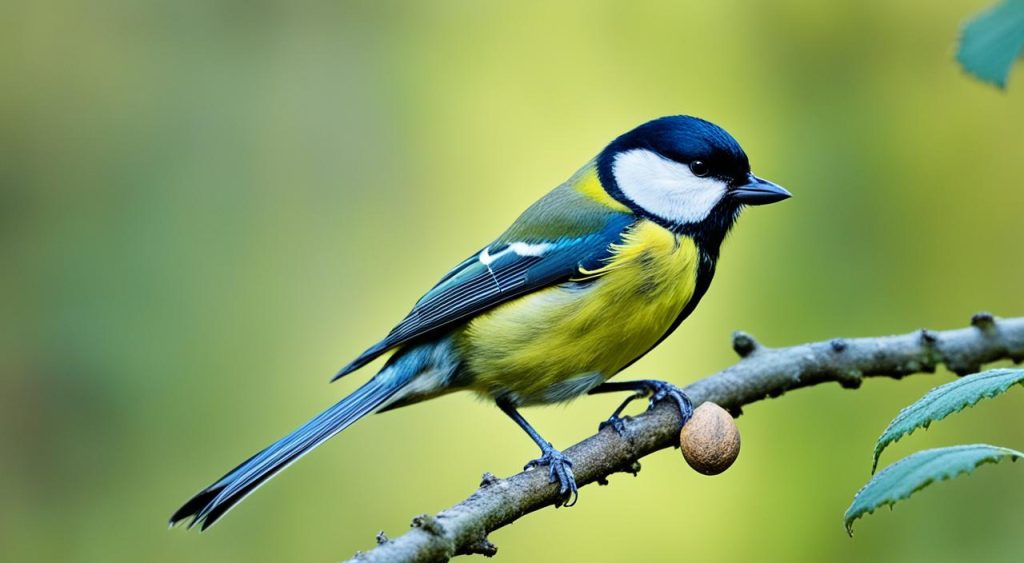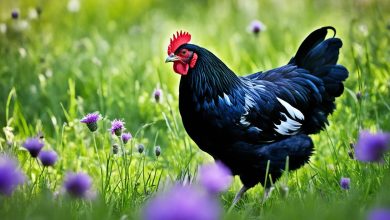The great tit (Parus major) is a small bird that lives in the tit family Paridae. It can be found in Europe, the Middle East, Central Asia, and across the Palearctic to the Amur River. This bird is known for its black head, white cheeks, and bright yellow underparts.
It’s a songbird that many people recognize. The great tit is one of the most common birds in Europe and Asia. It’s a favorite in gardens and a key bird for scientists who study birds.
Taxonomy and Subspecies of the Great Tit
The great tit is known by the scientific name Parus major. It is part of the Paridae family, which includes chickadees and titmice. Before, it was thought to have many subspecies. But now, thanks to genetic and sound studies, the cinereous tit (Parus cinereus) and the Japanese tit (Parus minor) are seen as their own species.
Today, we recognize 15 subspecies of the great tit. The most common one is P. m. major. It lives from the Iberian Peninsula to the Amur Valley and from Scandinavia to the Middle East. The other subspecies live in smaller areas, some only on islands.
Distinct Species: Cinereous Tit and Japanese Tit
The cinereous tit (Parus cinereus) and the Japanese tit (Parus minor) used to be seen as types of the great tit. But now, they are known as separate species because of their genetic and behavior differences.
Geographic Distribution of Great Tit Subspecies
- The most common type, P. m. major, lives in Europe and Asia.
- Other types, like P. m. aterrimus in Scandinavia and P. m. corsus on Corsica, have smaller areas.
- Some types live only on certain islands, such as P. m. amamiensis in the Amami Islands of Japan.
| Subspecies | Distribution |
|---|---|
| P. m. major | Iberian Peninsula to Amur Valley, Scandinavia to Middle East |
| P. m. aterrimus | Scandinavia |
| P. m. corsus | Corsica |
| P. m. amamiensis | Amami Islands, Japan |
The great tit and its subspecies cover a wide range of places. This shows how well they can adapt to different habitats and climates.
Physical Description of the Great Tit
The great tit is a big bird in the tit family, measuring 12.5 to 14.0 cm long. The Eurasian great tit has a special look with a bluish-black crown and black parts on its neck, throat, and head. It also has white cheeks and ear covers.
Its bright lemon-yellow breast has a wide black stripe running down from the bib to the vent.
Distinctive Appearance and Plumage
The great tit’s feathers show different looks across various subspecies. While they mostly look the same, the colors can vary. For example, the Turkestan great tit has silver-gray feathers on top and a whitish belly, unlike the brighter yellow of European birds.
Variations Among Subspecies
Male and female great tits look different. Males have brighter yellow bellies and a wider black stripe than females. The Eurasian great tit is almost as big as the Eurasian tree sparrow. Asian great tits have paler yellow bellies than those in Europe.
| Subspecies | Physical Characteristics |
|---|---|
| Eurasian Great Tit (P. m. major) | Bright yellow breast with thick black central line, bluish-black crown and head |
| Turkestan Great Tit (P. m. turkestanicus) | Silver-gray upperparts, whitish underside |
| Asian Great Tits | Paler yellow underparts compared to European populations |

The great tit is a visually striking bird. It has a variety of feathers that show its adaptability and diversity across its wide range.
Habitat and Range of the Great Tit
The great tit lives in many places across the Palearctic region. This includes Europe, the Middle East, Central Asia, and east to the Amur River. It loves living in different types of woods, like those with deciduous, coniferous, or mixed trees. It also enjoys urban parks and gardens in its great tit range.
Most great tits stay in one place all year, but they move during very cold winters. They are very good at living in various places. Great tit habitat includes not just old forests but also younger woods and even places changed by humans, like cities and suburbs.
- The great tit is one of the most common birds in most of Eurasia, with a stable and increasing population in many regions, including the UK.
- In the British Isles, the great tit is the largest species of tit, measuring between 12.5 to 14 centimetres in length.
- The species has even been spotted in specific local areas on the western shores of Lake Michigan in Wisconsin, USA, showcasing its great tit distribution beyond its primary Palearctic region.
This bird’s ability to adapt and its wide great tit habitat have helped it thrive. It’s a common and loved bird in European woodlands and city parks.
Feeding Habits and Diet
The great tit changes its diet with the seasons. In summer, it eats mostly insects and small invertebrates. Its favorite foods are moths, butterflies, beetles, bugs, flies, wasps, bees, and ants.
When winter comes, the great tit looks for different food. It eats seeds from beech and hazel trees, and various fruits. It still eats insects too.
Insectivorous Diet in Summer
The great tit is great at eating insects in summer. It hunts and eats many insects and small invertebrates. This helps control pests in its home.
Diverse Winter Food Sources
In winter, the great tit eats more seeds and nuts. This change helps it survive when there are fewer insects around. It shows how adaptable the birds are.

“The great tit’s ability to adapt its diet to seasonal changes is a testament to its resilience and ecological importance.”
Nesting Behavior and Reproduction
The great tit is a common bird in European woodlands, known for its unique nesting habits. These small songbirds prefer to live in cavities. They use natural hollows or nest boxes to build their homes.
Cavity Nesting and Egg Incubation
From March to July, the female great tit builds a cup-shaped nest. She uses materials like grass, moss, and feathers. The nest is usually found 1 to 5 meters off the ground, sometimes up to 12 meters high.
She lays about 12 eggs, with a range of 5 to 18. These eggs are 18 x 14 mm and weigh about 1.7 grams. The female incubates the eggs for 13 days. After hatching, both parents help raise the young, which leave the nest in 16 to 22 days.
Great tits usually have one brood a year, but sometimes they try for a second one. Their nests can be attacked by woodpeckers, squirrels, and weasels. Fleas can also be a problem.
Their nesting and breeding are key to keeping their population strong. They help maintain the balance in European woodland ecosystems.
Great Tit: Vibrant Bird of European Woodlands
The great tit, Parus major, is a bright and charming bird found in European woodlands. It’s known for its striking black, white, and yellow feathers. Birdwatchers and nature lovers enjoy seeing this bird because of its beauty. It adds to the diversity and richness of the woodlands.
This bird lives in many places, with fifteen different types found across Europe, North Africa, the Middle East, and parts of Asia. Each type looks a bit different, showing the great tit’s wide range and variety.
Research shows the great tit is key to its ecosystem. It eats a lot of aphids, which helps control their numbers. The bird also eats spiders, flies, and even hibernating bats, showing how adaptable it is.
| Subspecies | Distribution |
|---|---|
| Parus major major | British Isles, Europe, Asia Minor |
| Parus major newtoni | Northern and eastern Kazakhstan, southern Siberia, northern Mongolia |
| Parus major excelsus | Northern Africa |
| Parus major corsus | Corsica |
| Parus major balearicus | Balearic Islands |
The great tit’s bright colors and important role make it a favorite in European woodlands. By learning more about this bird, we understand the importance of these ecosystems better.

Adaptation to Human Environments
The great tit is a vibrant bird found in European woodlands. It has adapted well to live in areas changed by humans. It now thrives in urban parks and gardens, charming people with its presence. This bird’s skill in adapting to human environments has helped it succeed.
Common Presence in Urban Parks and Gardens
More people live in cities now, with over 54% in urban areas and this number expected to rise to 66% by 2050. The great tit has learned to live with humans. It has found a way to survive in the 0.5% of the Earth’s land that is urban.
Urban life brings challenges like noise and light pollution. But the great tit has adapted. It lives in cities, making parks and gardens its home. People love seeing this bird in the city, enjoying its beauty and behavior.
“The great tit’s presence in urban settings provides opportunities for people to observe and appreciate this vibrant bird up close.”
A 2016 study in Warsaw, Poland, looked at great tits and blue tits in the city. It showed how well these birds adapt to city life. Scientists studied their nests and how well they reproduce in urban areas. This research highlights the great tit’s ability to live with humans.
Threats and Conservation Status
The great tit is listed as Least Concern on the IUCN Red List. This means it’s not at high risk of going extinct. But, it still faces threats that could affect its survival over time.
Habitat loss is a big threat. As cities grow, the great tit’s woods are being cut down or split up. This reduces where it can live, nest, and find food.
Also, pesticides are a danger. They can kill the insects the great tit eats, especially when it’s raising its young.
Another threat is competition from invasive species. Non-native birds can take over the great tit’s homes and food, hurting its numbers.
| Threat | Impact |
|---|---|
| Habitat loss | Reduction in nesting sites and food resources |
| Pesticide use | Decline in insect prey population |
| Invasive species competition | Increased competition for resources and nesting sites |
Even with these dangers, the great tit is still common and widespread. We need conservation efforts and monitoring to keep it safe for the future.

“Keeping our birds safe is key to our ecosystems’ health. Saving species like the great tit helps protect our natural world and the birds we admire.”
Importance in Ornithological Studies
The great tit is key in ornithology research. Its behavior, ecology, and adaptations are studied in many research projects. This common bird helps us learn about avian biology. We learn about how it forages, nests, thinks, and how climate change affects it.
Studies show that the great tit’s exploratory nature is mostly due to genetics. The DRD4 gene affects its personality in the wild. This shows how genes and behavior are connected.
Research also proves that great tits act similarly in the wild and in captivity. This makes them a great model for studying behavioral syndromes and coping styles. It helps us understand avian behavior and ecology better.
| Statistic | Findings |
|---|---|
| Heritability of exploratory behavior in great tits | 0.5 to 0.7 |
| Association between DRD4 gene polymorphism and personality variation in great tits | Found across four wild populations |
| Personality in captivity vs. the wild | Reflects personality in the wild for great tits |
The great tit is a key model organism in avian behavior and ecology research. It gives us deep insights into how genes and the environment shape bird personalities. This affects their fitness and how they adapt.
Vocalizations and Songs
The great tit is known for its wide range of sounds, including calls and songs. These sounds are crucial for the birds’ social life and survival. They help in defending territories, talking to each other, and working together in pairs.
Scientists have studied the great tit’s sounds a lot. In 2008, they found that city great tits sang higher notes than those in the countryside. This is because cities are noisier. The birds in the city sang shorter songs and took less time between songs, showing they can change to live in noisy places.
The great tit’s song sounds like “Tee-cher, Tee-cher.” But, each bird can sing more than one song type. They change their songs over time to fit their homes and social lives.
- Great tits can have up to nine different songs in their repertoire. They learn these songs where they grow up and use them in their adult life.
- Some great tits sing “Cher-tee, Cher-cher, or Tee-tee,” but “Tee-cher” is the most common.
- They also make different calls like chirp, tonal, and D calls. These calls warn them of dangers like sparrowhawks and tawny owls.
Studies on the great tit’s sounds have taught us a lot about bird communication and how they adapt. These birds are a big part of the European woods. Their songs and calls are loved by birdwatchers and scientists.
Interactions with Other Bird Species
The great tit is a lively bird that lives in European woodlands. It often meets other birds in its home. While it rarely mixes with other species, its interspecific relationships and community interactions are important. They affect the balance in local avian communities.
Hybridization and Interspecific Relationships
The great tit mostly hangs out with other tit birds, like the blue tit. But great tit hybridization is rare. Most of the time, it stays true to its own kind. Yet, its interspecific relationships with other birds can be complex. They involve fighting over food, homes, and sometimes even eating together.
Studies reveal that great tits are 32% less likely to choose obvious food when they see another bird react to it. This shows how social transmission of information affects their eating habits. They learn from watching other birds, which helps them avoid risky situations.
| Bird Species | Interspecific Feeding Observations |
|---|---|
| House Sparrow | Commonly reported in gardens |
| Wren | Commonly reported in gardens |
| Robin | Frequently reported as engaging in cross-species feeding, including rearing a great tit brood |
| Blue Tit | Commonly reported in gardens |
| Starling | Commonly reported in gardens |
| Blackbird | Observations of feeding a young Jay, a known predator of Blackbird eggs and young |
| Nuthatch | Commonly reported in gardens |
Why birds feed together is still a mystery. It might help them learn how to be parents or be an accident. Being fed by another bird could also affect how well they socialize and find a mate later on.
The great tit’s interactions with other birds, through hybridization or community dynamics, are key to understanding the avian ecosystem. They help us grasp the complex social behaviors in nature.
Evolutionary History and Genetics
The great tit’s evolution and genetics have been deeply studied. Genetic studies show that the great tit belongs to the “non-hoarder” group of tits in the Parus genus. It separated from species like the cinereous tit and Japanese tit about 1.5 million years ago.
This bird’s wide spread and similar looks suggest it quickly grew its population after the last ice age. Studies on the great tit’s genetic diversity found lots of genetic variation and signs of recent evolution. This evolution is in genes linked to brain function, thinking, and learning.
Genome studies also found special evolution patterns in the great tit. The Z chromosome and autosomes have different evolutionary paths. This is because of the bird’s way of mating, which involves more males and females.
| Key Findings | Significance |
|---|---|
| Genetic analyses of the great tit reveal it belongs to the “non-hoarder” lineage of the Parus genus | Provides insights into the evolutionary relationships and divergence of the great tit from closely related species |
| The great tit population underwent expansion interrupted by a mild decline around 110 Kyr ago | Suggests the species’ distribution and genetic diversity were shaped by climatic changes during the last glacial period |
| Positive selection detected in genes related to neuronal function, cognition, and learning | Indicates adaptations that may have enhanced the great tit’s cognitive abilities and behavioral flexibility |
| Lower than expected Z-to-autosome effective population size ratio | Reveals unique evolutionary dynamics between sex chromosomes and autosomes, potentially driven by the species’ polygynous mating system |
The evolutionary history and genetic diversity of the great tit offer deep insights into avian phylogenetics and how this bird species adapted. This knowledge is crucial for understanding the great tit’s role in nature.
Fascinating Behaviors and Adaptations
The great tit is a bird that stands out with its interesting behaviors and adaptations. It’s known for using tools. These birds use things like conifer needles to get insects from tight spots. This shows they have a smart way of thinking, which is not common among birds.
Not only do they use tools, but the great tit also solves problems well. They learn fast to avoid certain insects that warn them with bright colors. This shows they can adapt and learn new things. They even learn from each other, which helps them survive better.
These great tit behaviors and ways of adapting have caught the eye of scientists. They keep finding out more about how smart these birds are. By studying them, we learn a lot about how birds have evolved to be smart. It shows us how nature has helped these birds live well in Europe’s forests.
“The great tit’s ability to use tools and quickly learn from its peers is a testament to the remarkable adaptations and cognitive abilities of this iconic European songbird.”
Cultural Significance and Folklore
The great tit is a bright and lively bird found in European woodlands. It has a special place in the culture and stories of these areas. People see it as a sign of good luck or the start of spring.
In Europe, the great tit is well-known and loved in art, literature, and culture. Its unique look and sweet sounds, like a 2-note call, have caught people’s hearts for many years.
“The great tit is a symbol of resilience, adaptability, and the enduring beauty of nature in our lives.”
In Estonia, the great tit is highly respected. It’s thought to bring health and keep away bad spirits. This bird is also important in folklore and traditional beliefs across Europe.
The great tit plays a big role in nature, eating lots of insects and caterpillars. People have always valued its help in controlling pests. This has made it a cherished and important bird in many places.
Learning about the great tit’s cultural importance helps us understand our connection with nature better. This bird’s place in European stories shows the lasting impact of birds on our lives and culture.
Future Research and Conservation Efforts
The great tit is a key species for ongoing research and conservation work. Scientists will likely study how climate change affects its behavior and interactions with other birds. They will also look into the genetics behind its ability to adapt.
Protecting the great tit’s woodland homes is vital for its survival. Researchers aim to improve urban planning to help these birds and other species. They want to create policies that focus on the needs of birds like the great tit.
The great tit has been studied for a long time, giving us insights into environmental impacts, especially climate change. As research changes, the great tit will keep being a key subject. It will continue to help us understand how to protect our environment.
FAQ
What is the great tit?
The great tit is a small bird that lives in many places. It’s found in Europe, the Middle East, Central Asia, and parts of Asia. It has a black head and neck, white cheeks, and yellow belly.
How many subspecies of the great tit are there?
There are 15 subspecies of the great tit. The most common one, P. m. major, lives from the Iberian Peninsula to the Amur Valley and from Scandinavia to the Middle East.
What are the key physical features of the great tit?
The great tit looks unique. It has a bluish-black crown, black neck, and throat. Its cheeks and ear covers are white. Its breast is bright yellow with a black stripe from the bib to the vent.
Where can the great tit be found?
You can find the great tit in many places. It lives in Europe, the Middle East, Central Asia, and parts of Asia. It stays in woodlands and doesn’t migrate much, except in very cold winters.
What does the great tit eat?
In summer, the great tit eats insects and small invertebrates. In winter, it eats a variety of foods, including small hibernating bats, seeds, and plant matter.
How does the great tit nest and reproduce?
The great tit nests in tree holes. The female lays about 12 eggs and incubates them alone. Both parents help raise the chicks. They usually have two broods a year.
What is the cultural significance of the great tit?
The great tit is important in many cultures. It’s seen as a sign of good luck or the start of spring in some traditions.
What is the conservation status of the great tit?
The great tit is not at high risk of extinction, classified as Least Concern by the IUCN Red List. But, it faces threats like habitat loss, pesticide use, and competition with invasive species.
Why is the great tit an important study species in ornithology?
Scientists study the great tit because it’s common and widespread. Its behavior and ecology offer insights into bird biology. It’s a key species for research.




